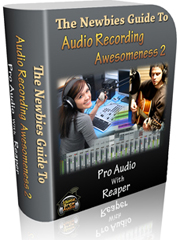 Our latest audio recording course is the Newbies Guide To Audio Recording Awesomeness 2: Pro Recording With Reaper, which is the second home recording course in our “Newbies Guide” series. The first course was designed for folks who have little or no budget for gear or software to start doing audio recording. Therefore, it makes use of the free recording program, Audacity, which you can download and start using immediately, and “any mic you happen to have,” including a $5.00 plastic computer mic.
Our latest audio recording course is the Newbies Guide To Audio Recording Awesomeness 2: Pro Recording With Reaper, which is the second home recording course in our “Newbies Guide” series. The first course was designed for folks who have little or no budget for gear or software to start doing audio recording. Therefore, it makes use of the free recording program, Audacity, which you can download and start using immediately, and “any mic you happen to have,” including a $5.00 plastic computer mic.
The first course is NOT a prerequisite for the second one! It is simply designed for those with a bit more of a budget for software and gear. It makes use of Reaper recording software, which is decidedly professional audio recording software (technically called a digital audio workstation or DAW), and yet whose cost is amazingly low. In fact, The Reaper folks have something they call the honest business model. First is the 30-day free trial, which is a fully functional version of the software AND doesn’t actually stop working after 30 days. Yes, you will get a notice telling you the software is not free after that time, but if you need more than 30 days, you can have more time to evaluate Reaper. Then – and this is the really amazing part – you decide whether to pay $225 or $60 for a full license to Reaper! What? Yup. If you are a business making more than $20,000 (USD) per year, then you should buy the commercial license for $225. If you don’t make that much, you pay $60. And nobody is going to check. It’s based on the honor system. I don’t know of anyone else who does this. Simply amazing.
Anyway, the Newbies Guide To Audio Recording Awesomeness 2: Pro Recording With Reaper also starts you from scratch and teaches the basics of audio recording – just like the first course – it simply goes further and teaches you a lot more cool stuff (time-saving voice-over automation tips and tricks, multi-track recording, MIDI, virtual instruments, and much more), mainly because Reaper is capable of doing all that stuff.
Click here for two free videos from the course.
Check out the video below, which is sort of a walk-through of the course:
Reaper Tutorial Home Recording Course Video
voice-over
Bad Voice-Overs Ruin Great Looking Videos
 If I had to estimate what percentage of very professional-looking sales videos on the web were accompanied by crappy audio due to poor voice-over quality, I’d have to say at least 50 percent. That’s a lot folks! And there is no reason for it – none at all. Audio for video is not hard. If your videos are just for fun, the narration quality may not be that important. But videos for your business affect the bottom line, and amateur-sounding audio might well be limiting how successful you are.
If I had to estimate what percentage of very professional-looking sales videos on the web were accompanied by crappy audio due to poor voice-over quality, I’d have to say at least 50 percent. That’s a lot folks! And there is no reason for it – none at all. Audio for video is not hard. If your videos are just for fun, the narration quality may not be that important. But videos for your business affect the bottom line, and amateur-sounding audio might well be limiting how successful you are.
When someone goes through the trouble of creating a sales video they usually have a goal of – oh I don’t know – selling something. With that in mind, the wise salesperson will want to put forward as professional an image as possible within their budget. One of the ways they do this is to produce a very nice-looking video with professional graphical design, and carefully crafted copy to tell the right story. Then, for the final touch, they decide to record the narration for this video in such a way that it sounds like they’re in a shower. At least that’s my experience as a consumer of these videos (I watch a lot of them so I can learn what to do and, apparently, what not to do:P). I’m not certain what these folks are thinking, but a lot of them must feel like as long as it is intelligible and gets the message across, it’s fine. Uh, no. When I see a great video with crappy voice over quality due to poor audio recording choices, in my mind the presentation can literally be down-graded from “pro” to “amateur.” Don’t you don’t think THAT affects sales?
The odd thing about this is the reason, typically, for the poor audio. It’s usually something silly like being too far away from the mic in a less-than-ideal acoustic space (which includes just about every room in most houses, by the way). The fix is so easy. GET CLOSER TO THE MIC. The closer your mouth is to the mic, the more of you is recorded, and the less the room figures into the equation. I recommend 3-4 inches if possible. You can go the extra mile and hang a moving blanket behind the microphone, but for the most part just getting closer to the mic will make a huge difference.

Now when you are recording video, especially if you’re doing a “talking head” type of video, logistics dictate that your mouth (or that of the person talking) will be a few feet away from the camera. You have a couple of choices. If your camera has an external mic jack, use it! That way you put a mic close to the narrator’s mouth. You can also use a lavalier type mic like the Azden WMS-Pro for this. (The Azden also comes with a hand-held mic).
I did a review video of the Azden, comparing the sound of just the camera’s mic with that of the lav, in this post: https://www.homebrewaudio.com/audio-quality-for-videos/

If your camera does not have an external mic connector, the other alternative is to record the voice totally separate from the camera. The will be recorded either into a computer or a mobile recorder like the Zoom H4 Handy 4-Track Recorder (which can double as a computer audio interface – very cool!). Then just load up the video in your editor (I’m a fan of Sony Vegas), which will also load the audio recorded on the camera’s built-in mic. That’s fine. Simply import the voice audio you recorded separately and place it on a new audio track underneath the one you loaded from the camera. Now you can just line up the two audio tracks by nudging the audio-only track, delete the audio track that got recorded from the camera, and presto! Pro audio instead of the cruddy camera-recorded sound.
Several of the above tips won’t require you to buy anything! A common misconception is that pro audio can only come from great big microphones costing hundreds (or thousands) of dollars. That is not true. It’s more about the knowledge of acoustics and microphones and recording than it is about the gear. For video narration purposes you can get perfectly professional quality audio with a USB mic (like the Samson Q1U) costing around $49, as long as you have just the barest bit of audio knowledge, which you can get from many a tutorial and article at Home Brew Audio.
Record Your Voice And Sound Like A Pro
 When you record your voice, are you happy with the result? Well, let me ask it a different way because a lot of people simply hate the way their voice sounds to them when they hear it played back on a recording, regardless of the audio quality. That’s a different thing. I’m referring to whether the sound is nice and clear without a lot of noise in the background.
When you record your voice, are you happy with the result? Well, let me ask it a different way because a lot of people simply hate the way their voice sounds to them when they hear it played back on a recording, regardless of the audio quality. That’s a different thing. I’m referring to whether the sound is nice and clear without a lot of noise in the background.
A lot of people don’t really know if their voice sounds “good” or not. If they can be understood and heard by others, they feel it is good enough. And it may be good enough for what you’re doing! I mean, if all you want to do is chat with family and friends over Skype or some other internet meeting, it may not be all that important that your voice sound “professional.”
But if you are recording your voice for any kind of business reason, such as for podcasts, videos, or voice-overs, then it might be time to listen critically to a recording of your voice and assess it for how professional it sounds. Is there a lot of hiss or other types of noise in the background? Maybe the audio is “thin” sounding? Heck, even then you might not hear anything wrong! I have a friend who is a successful internet marketer, video-blogger, and podcaster. She had no idea that her audio sounded bad enough that it made her sound like an amateur. It wasn’t until someone recorded her with a decent microphone that her eyes were opened (maybe the metaphor here should say “ears were opened,” but I digress). she didn’t realize how bad her voice sounded until she heard how it COULD sound with the right equipment – in her case, just a slightly better microphone.
The Microphone

Notice I said “slightly better microphone” above. When people think of home studio microphones the often think expensive, assuming they will have to spend hundreds or even thousands of dollars. My friend was using a USB headset mic costing about $35. Someone recorded her voice with a microphone costing only about $100 called the Blue Yeti, which is also a USB mic, meaning all you have to do is put it on your desk and plug it into your computer. No mixers or interfaces are involved. Anyway, when she heard playback of her voice recorded on the Yeti, she was stunned! “Oh my god,” she said. “I had no idea.” For only about $75 more than the headset mic she was using, her voice went from sounding “OK” to “Oh my god.”
The Yeti is a good microphone, but the good news is that my friend could have gotten the “oh my god” reaction with an even less expensive USB mic such as the Samson C01U, which you can pick up at your local Best Buy store for around $75 (only a $40 difference from “OK” to “oh my god” this time).
 The main reason the Yeti and the Samson C01U mics sound so much better than the headset type mic is the size of the microphone element or diaphragm inside. The bigger mics are called “large diaphragm condenser” mics. There are other differences as well, such as the fact that headset USB mics are usually dynamic type mics which are typically less sensitive than condenser mics. But you probably don’t care much about that.
The main reason the Yeti and the Samson C01U mics sound so much better than the headset type mic is the size of the microphone element or diaphragm inside. The bigger mics are called “large diaphragm condenser” mics. There are other differences as well, such as the fact that headset USB mics are usually dynamic type mics which are typically less sensitive than condenser mics. But you probably don’t care much about that.What is important is that if you need to record your voice and have it sound professional, a really smart way to make that happen quickly and easily (not to mention cheaply) is simply to use a large diaphragm condenser (LDC) type USB mic. There are many levels of “OMG” above even that of course, which involve different kinds of microphones at higher cost. But for most people, the upgrade to an LDC USB mic for less than $100. It is a small price to pay for professional quality voice audio.
I’d love to hear some before-and-after audio if you decide to make this change. Send in a comment below and maybe we can post some examples.
Cheers – and happy recording!
Why Some Voice-Over Auditions Get Thrown Out Immediately
 If you’ve been a regular reader of this blog, then hopefully you know that your computer is an excellent home recording studio, an you can record professional voice-overs (as well as music and any other audio recording projects) right from home. If you are one of the many voice-over actors on our list who daily answer voice casting auditions at Voices.com (or anywhere else), you probably also know that you have to be persistent. I’ve found that as with any acting job, you have to do lots and lots of auditions for every job you land. To quote Tom Hanks from the movie A League of Their Own, “It’s the ‘hard’ that makes it good.” But that doesn’t mean you can’t improve the odds. It is helpful to know that certain kinds of auditions get immediately thrown out by a client. Of course, it would also help if those weren’t yours.
If you’ve been a regular reader of this blog, then hopefully you know that your computer is an excellent home recording studio, an you can record professional voice-overs (as well as music and any other audio recording projects) right from home. If you are one of the many voice-over actors on our list who daily answer voice casting auditions at Voices.com (or anywhere else), you probably also know that you have to be persistent. I’ve found that as with any acting job, you have to do lots and lots of auditions for every job you land. To quote Tom Hanks from the movie A League of Their Own, “It’s the ‘hard’ that makes it good.” But that doesn’t mean you can’t improve the odds. It is helpful to know that certain kinds of auditions get immediately thrown out by a client. Of course, it would also help if those weren’t yours.
Why I (as a voice-talent hiring client) toss auditions
1. Non-custom audition
As someone who has both auditioned AND hired voice talent from Voices.com, I can tell you one thing for certain – sending demo reels with recordings that don’t answer the specific need of the client is one way to get your audition ignored completely. When, as a client, I say in the job description something like “I need a celebrity impersonation of President Obama,” and one of the auditions is a demo reel of cartoon voices and car commercials, I click the Stop button immediately and move on. Just take the extra time and record something that the client actually asked for. It’s fine to send a demo that you already have if it matches the client’s description, or if they don’t really give a description. Otherwise, leave the demo reel for your profile page or promo kit.
2. Poor recording quality
Another thing that causes auditions to get set aside is a poor quality recording. See our tips here for getting the best recording possible regardless of what gear you use (that series of articles also tells you all about the gear!) – How to Build a Home Recording Studio: Part 2 – Four Tips For Preventing Noise . It is so inexpensive, gear-wise these days, that there is really no excuse not to spring for the $75 or so for a decent USB mic at the very least – if you’re serious about making the voice-over thing into regular paying gig.
If you have the gear, but are just not happy with the quality of your sound, or time it takes to record demos and jobs, you can learn to fix both problems in our new home recording video tutorial course. Check it out here: The Newbies Guide to Audio Recording Awesomeness 2.
So now you know how not to have your auditions immediately thrown onto the garbage heap. If you’re keeping track of how often you land a voice-over gig, this should improve your job-to-audition ratio greatly.
Good luck!
For another take on why voice-over auditions get chucked, check out this article by Derek Chappell: http://thevoiceofyourbusiness.com/blog/2012/09/27/why-do-95-of-demos-get-tossed/
If I Want To Begin A Home Recording Studio For Audio Books?
Below is the latest in Home Recording Yahoo Answers Q&As. There is a bit of a departure in this question, as it relates primarily to starting an audio business. Also, the answer that was posted is pretty much in line with our advice! That, also, is a departure from the norm;). See the Home Brew Audio reply to this question at the end of the post.
Q: I am thinking about putting together a home audio studio to record audio books. Any ideas what equipment I might need? I already have a microphone with a usb hook-up. Will I also need an interface of some kind? And what about a sound room? Can you make much money recording audio books? Thanks.
A: With a USB mic you can download audacity and start recording right away. Record in a small room or build your own isolation booth to reduce room noise in the recording.
There might be some legal issues to worry about regarding rights to the work. I have no idea who to contact about that . Maybe the publisher, if you can find out who that is.
On the budget question, I can see going either way. You’ll probably wont make much unless you land a deal to do a lot of books or something like that, which is actually pretty unlikely and rare.
Here is the Home Brew Audio answer.
We agree with starting out using the USB mic. If the mic is close enough to your mouth, and you don’t have a lot of noise in the room, you don’t really need a sound room. However, anything you can do to reduce room noise (the reverb and echo that comes off the walls in the room) and other noise (babies crying, dogs, lawn mowers, etc.) would be helpful. We disagree with the “small room” aspect of the published answer. A bedroom would probably suffice, but the bigger the room, the longer it takes sound waves to travel to walls and ceilings and back again, so close-mic-ing will work better (less echo and reverb).
There are two excellent articles on this site that will help you. First is about voice-over recording and how to get started – Voice Over Jobs: Useful Tips For Landing Them and the 5-part series How to Build a Home Recording Studio.
As far as the money to be made — voice over work is extremely competitive. there is money to be made, but you have to be VERY persistent about auditioning for work. BTW, do NOT just read a copyrighted book and try to sell it. That is extremely illegal. If you want to sell your own book projects, go to Librivox.org for a catalogue of books in the public domain.
Cheers!
Ken